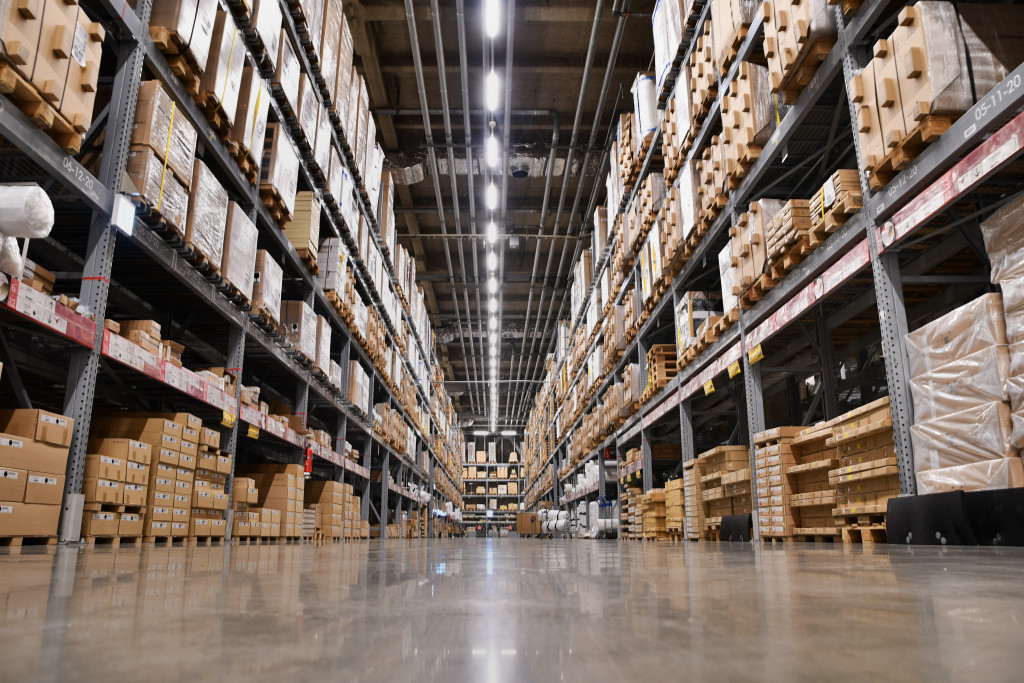- Perform periodic inspections of the floors to detect potential hazards or damages.
- To improve safety and ensure longevity, cleaning and sealing the floor regularly is recommended.
- To decrease the chance of slipping and falling, ensure the floors are clear of clutter, spills, debris, or obstructions.
- To enhance visibility and safety, ensure that the pathways are well-lit.
When it comes to warehouse safety, the floor is often overlooked. However, a safe and well-maintained warehouse floor is essential for protecting the health of your employees and goods. Unsafe floors can lead to slips, trips, falls, and other accidents that can cause significant damage or injury.
Fortunately, there are several steps you can take to ensure your warehouse floors remain safe and secure for everyone who passes through them. By following these tips, you’ll be able to ensure warehouse safety for all those who enter it.
Investing in high-quality epoxy tech floor coating

Investing in high-quality epoxy tech floor coating is wise for those prioritizing warehouse safety and durability. This type of coating is a thick, protective layer that bonds to a concrete surface, making it resistant to damage and slip-resistant. Utilizing high-quality epoxy tech floor coating ensures that your floors are visually appealing and easier to clean and maintain.
Furthermore, the slip-resistant property of the coating can reduce the risks of accidents due to slips and falls in the workplace. By investing in a good quality epoxy tech floor coating, not only are you able to save money over time, but you are also ensuring the safety of your employees and the longevity of your flooring.
Implementing floor safety procedures
Implementing floor safety procedures is essential for a safe work environment. Here are some tips on how you can ensure your warehouse floor is as safe as possible:
Inspecting the floors regularly
Regular inspections of warehouse floors are crucial for maintaining safety in industrial settings. It is important to emphasize the significance of considering inspections not solely as a chore but as a preventative measure against potential hazards. Carrying out regular inspections can help identify any signs of damage or wear and tear that can compromise the integrity of the flooring in warehouses and ultimately endanger workers.
Failing to spot these hazards on time could lead to worker injuries, costly legal claims, and even business reputation damage. Therefore, warehouse owners and managers must prioritize regular inspections for maintaining a safe and secure work environment.
Ensuring proper floor maintenance
Good floor maintenance protocols must cover all the essential aspects of cleaning and sealing involved in maintaining safe flooring for your warehouses. Ensuring proper floor maintenance minimizes the risk of potential safety hazards since accidents caused by trips, slips, and falls are prevalent in any workplace.
By making the right assessments and checking for any potential slip, trip, and fall hazards, warehouse owners can take proactive measures that help create safer working environments. Not only does floor maintenance help reduce slips, trips, and falls, but it also improves the longevity of the flooring, saving business owners considerable amounts of money that otherwise would have been spent on expensive flooring repairs or replacement.
By staying proactive and investing in proper floor maintenance, warehouses can benefit from higher productivity levels and safer working conditions, resulting in improved morale, increased sales, and long-term business success.
Keeping the floors free from clutter
Properly considering the conditions of the warehouse floorings is imperative for workers’ health and safety. Keeping the floors free from clutter, spills, debris, and obstructions ensures that employees can move freely without fear of injury.
Not only are slip-and-fall accidents a major cause of injury in the workplace, but they can also incur costly medical bills and potential lawsuits. Obstructed pathways can also hinder the movement of machinery and equipment, leading to lost productivity and decreased efficiency. To maintain the safety and productivity of workers, it is essential to regularly inspect and clean warehouse floors to prevent any potential hazards.
Making sure that pathways are well-lit

In any warehouse facility, safety should always be a top priority. This includes preventing accidents and injuries caused by slips, trips, and falls. One effective way to do this is by ensuring that all pathways within the warehouse are well-lit, even during night shifts or in low-light areas. Proper lighting helps workers move safely and efficiently throughout the facility and reduces the likelihood of accidents caused by poor visibility.
Aside from the physical harm resulting from falls, workplace accidents can cost companies thousands of dollars in medical bills, workers’ compensation claims, and lost productivity. By considering the importance of well-lit pathways, businesses can proactively protect their employees and maintain a safe and productive work environment.
Installing appropriate signage
Properly considered signage is essential to ensure safe warehouse operations, particularly for indicating potential hazards on the floor. With adequate warnings, employees know where to remain cautious and take necessary precautions. This way, they reduce the risk of accidents and injuries while on duty.
Installing appropriate signage is not just a legal requirement; it is an ethical obligation for employers to protect their workers from harm. One must recommend investing in quality signage that is visible, concise, and informative. This improves workplace safety, reinforces employee hazard awareness, and ultimately saves time and money that would have been used to address accidents or lawsuits.
These are just a few steps warehouse owners and managers can take to ensure their floors remain safe and secure. Warehouse owners can create a safe and productive work environment for anyone who enters their facility by following these precautions.



